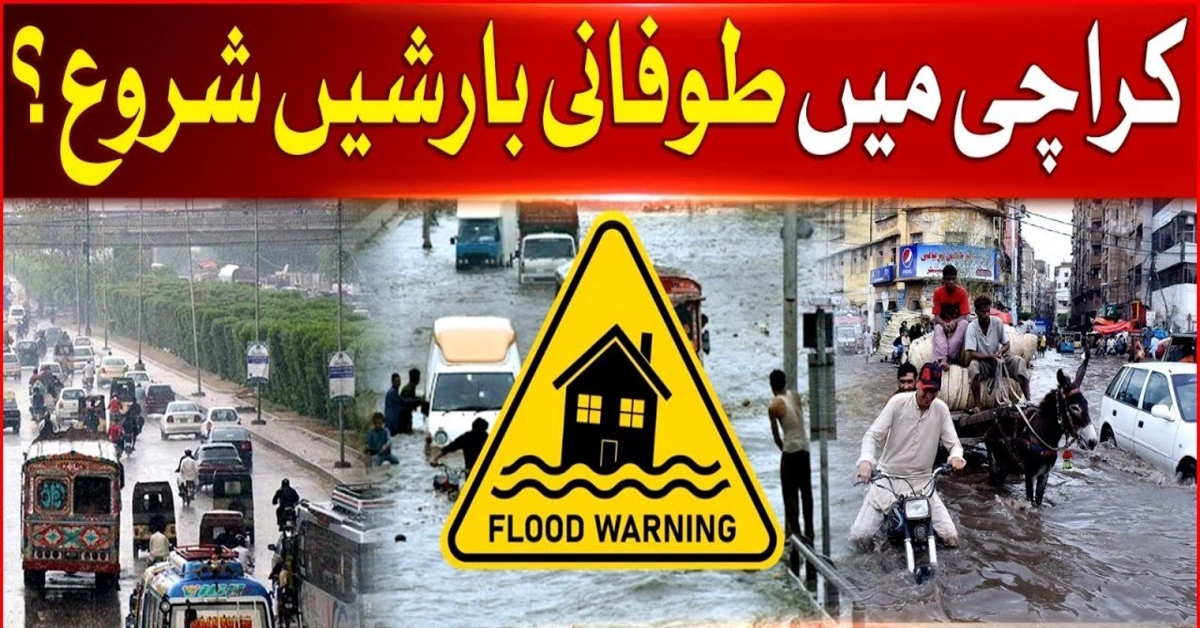Karachi weather turns dangerous as heavy rains increase urban flooding risk, raising serious concerns for city safety and residents’ protection.
Overview
The recent spell of heavy rainfall has once again highlighted the vulnerability of Karachi, Pakistan largest metropolitan city. With a rapidly expanding population, outdated drainage systems, and unplanned urbanization, the city faces recurring challenges whenever monsoon clouds appear.
The latest Karachi weather updates show intermittent heavy showers that have already raised fears of urban flooding, road blockages, and public safety risks. For millions of residents, each downpour is not just about rain—it is a reminder of the city’s fragile infrastructure and the urgent need for sustainable planning.
Karachi Weather and Monsoon Patterns
Karachi experiences a semi-arid climate, but the arrival of the monsoon season between July and September often disrupts daily life. While rainfall offers relief from scorching summer heat, it also brings devastating consequences for a city with insufficient drainage and poorly maintained roads.
Meteorological reports often highlight sudden shifts in Karachi weather, making it harder for authorities and citizens to prepare in advance.
In recent years, the intensity of rains has increased, turning normal showers into torrential downpours that overwhelm the city’s infrastructure.
The Growing Risk of Urban Flooding
Urban flooding has become a seasonal crisis in Karachi. Every year, major intersections, low-lying areas, and residential colonies get submerged after heavy showers. The reasons are clear:
Blocked Drainage Systems – Garbage and waste clog storm drains, leaving no outlet for rainwater.
Unplanned Urbanization – Rapid construction on natural waterways prevents proper water flow.
Weak Infrastructure – Roads, underpasses, and sewerage lines cannot handle the volume of water.
Rising Sea Levels – Being a coastal city, Karachi faces additional risks from tidal movements during storms.
Experts warn that without long-term reforms, the flooding situation will worsen each year, particularly with changing Karachi weather patterns.
Source: Geo news
Government Measures and Preparedness
Authorities in Karachi have repeatedly announced measures to tackle urban flooding, but results remain mixed. Some ongoing efforts include:
Cleaning of Storm Drains (Nullahs): Before every monsoon, teams are deployed to clear blockages.
Installation of Dewatering Pumps: Temporary solutions are set up in flood-prone areas.
Weather Alerts: The Meteorological Department issues timely updates on Karachi weather to prepare citizens.
Disaster Management Plans: Sindh’s disaster management authority coordinates with city officials during emergencies.
Despite these initiatives, critics argue that a lack of consistency, corruption, and overlapping jurisdictions prevent long-term progress.
Voices from the Citizens
Public opinion reflects frustration mixed with resilience. Many residents believe that while heavy rainfall is natural, the suffering caused by urban flooding is man-made. Citizens often highlight that cities around the world experience similar or heavier rains but rarely face such prolonged chaos.
Social media is flooded with images and videos of submerged cars, pedestrians wading through knee-deep water, and calls for immediate action. Hashtags like #KarachiWeather and #KarachiFloods trend regularly during monsoon, showing the global attention these recurring issues receive.

Climate Change and Future Risks
Scientists warn that climate change is intensifying rainfall patterns in South Asia. Karachi, being a coastal city with weak urban planning, stands at high risk of climate-induced disasters. The future could bring:
Heavier Rainfall Events – Short but extremely intense downpours.
Rising Temperatures – Longer heatwaves followed by sudden storms.
Coastal Flooding – Higher sea levels merging with rainwater flooding.
This makes it crucial for Karachi to adopt climate-resilient infrastructure and invest in smart city planning.
Also Read: TikToker Amna Baig Arrested in Karachi for Celebratory Firing
What Can Be Done?
Experts suggest a multi-dimensional approach to reduce the urban flooding crisis:
Modern Drainage Systems: Replace outdated pipelines with higher-capacity networks.
Green Infrastructure: Create parks and open spaces to absorb rainwater.
Public Awareness Campaigns: Educate citizens on waste disposal to prevent drain blockages.
Investment in Technology: Use smart sensors and AI for real-time monitoring of rainfall and water levels.
Disaster Preparedness: Train local communities to handle emergencies before authorities arrive.
By adopting a mix of engineering, environmental, and social strategies, Karachi can reduce its vulnerability to extreme weather conditions.
Final Thoughts
The latest Karachi weather reports have once again highlighted the urgent risks posed by heavy rainfall and urban flooding. While monsoon showers bring much-needed relief from heat, they also expose the weaknesses of city planning and governance. Without immediate reforms, every rainy season will continue to be a crisis for the people of Karachi.
Ensuring city safety requires more than short-term measures. It demands long-term vision, sustainable urban planning, and collective responsibility from both authorities and citizens. Karachi, the financial heart of Pakistan, deserves infrastructure that matches its importance. Until then, the cycle of rains and floods will remain a seasonal nightmare for its residents.




Join The Discussion